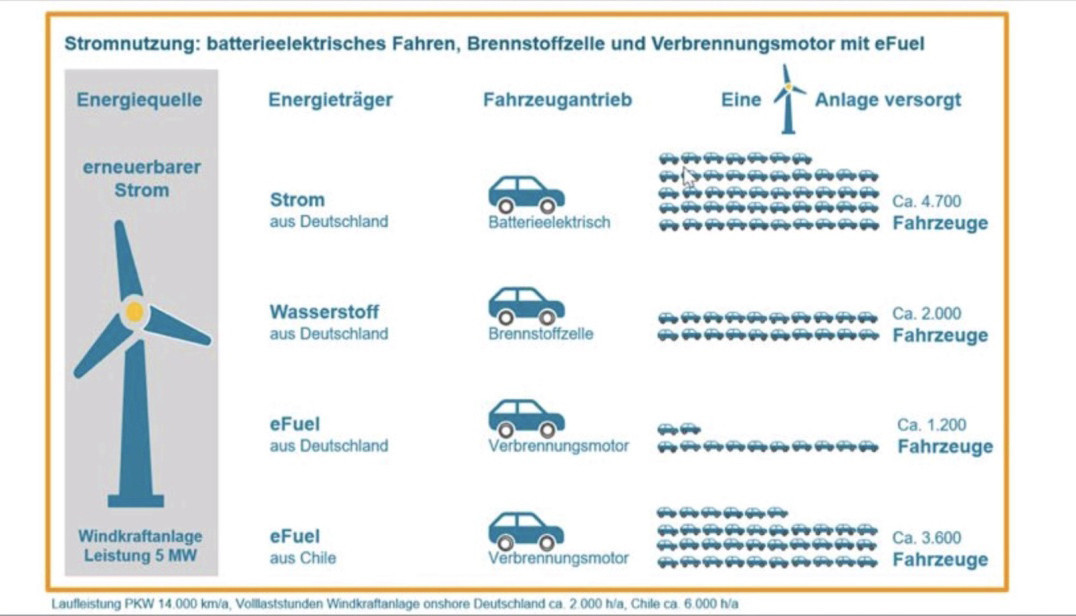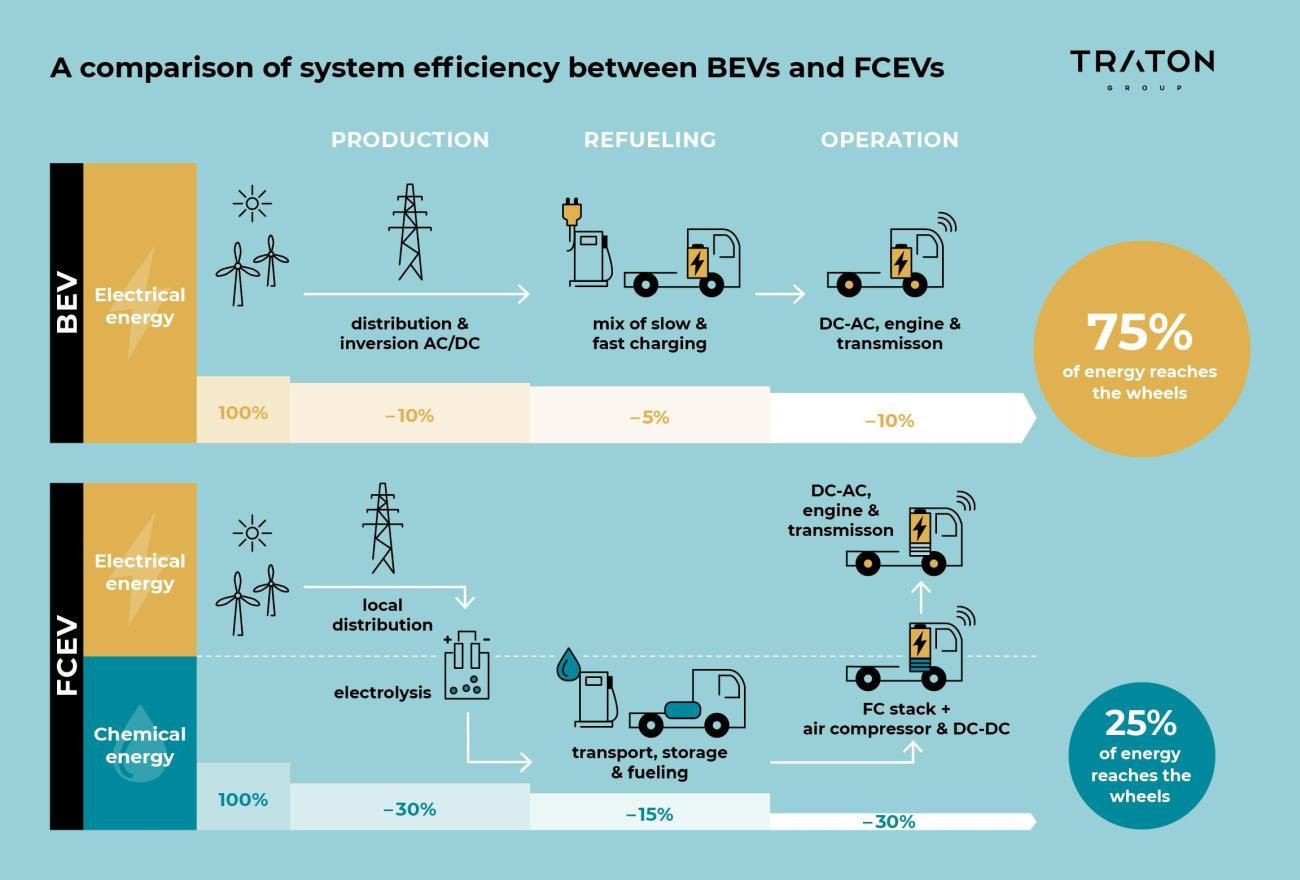Weak point of wind and solar power
If you want something, you find a solution, if you don't want something, you find an excuse! Unfortunately, our politics and therefore the authors of laws, rules and bans are more ideological than ever. Engineering and physical knowledge is often ignored, misunderstood or distorted due to a lack of education.
One thing at a time. Today, let's look at the question of why synthetic fuels and hydrogen can make sense, even if their efficiency is very low(Fig. 1).
Efficiency curve for different drive types, but efficiency is not the crux of the matter
If you compare the different technologies for passenger car drive systems, there are significant differences as Figure 2 shows. The figure from Technologie & Environment from 2017 is the favorite foil of almost everyone who wants to make a drive form with hydrogen or even synthetic fuel via the combustion engine absurd.
 Fig. 2: Efficiency curve from green electricity to the drive wheel
Fig. 2: Efficiency curve from green electricity to the drive wheel
BEV: In a battery electric car, there is a loss of around 5% from the wind or solar farm to the battery (well to tank). From the tank (battery) to the wheel (drive wheel) when converting from alternating current to direct current (AC/DC), there is a further 5% loss, as well as 5% battery loss and 5% loss when converting from direct current to alternating current (DC/AC). A further 10 % is added to the efficiency of the electric motor, resulting in an overall efficiency of 73 %.
Hydrogen: The efficiency of hydrogen is lower. Electrolysis for the production of hydrogen (H2) consumes 30 % of the electrical energy input, while transport and storage losses account for a further 26 %. The reconversion of H2 in the fuel cell into electrical energy consumes another 50 %. A further 5 % is consumed in the conversion from direct current to alternating current (DC/AC). A further 10 % is added by the efficiency of the electric motor, resulting in an overall efficiency of 22 %.
E-fuel: In synthetic fuel production, as shown above, initially 30% energy is lost in the electrolyzer during hydrogen production and 37% during FT synthesis (developed in Germany around 1920 according to Fischer-Tropsch). A further 70 % of the remaining energy is lost in the combustion engine as efficiency, leaving an overall efficiency of 13 %.
Both hydrogen and synthetically produced gasoline, diesel or kerosene can be transported over long distances (ship, pipeline, tanker train, rail). Large quantities of H2 can also be stored in underground gas storage facilities like natural gas or in large tank facilities for e-fuels.
Electricity, on the other hand, can only be transported over long distances at a disproportionately high financial cost. An economic no-go and the reason why Desertec (solar energy from North Africa) failed around 15 years ago. It would have required hundreds of very expensive underwater cables, e.g. from North Africa to Europe. In addition, there would have been high line losses and conversion losses (AC/DC).
E-fuels and hydrogen can be produced in remote windy areas because they can be stored
A large wind turbine with an output of 5 MW operates on average 2000 hours at full load on land in Germany. In contrast, the same turbine in windy Chile can achieve around 6000 full-load hours. According to Figure 3, instead of 4700 battery-electric cars, 3600 cars powered by eFuel with combustion engines could also be operated with an annual mileage of 14,000 km. Taking into account transportation losses from Chile to Europe, this would only be around 25% fewer vehicles.
Incidentally, Porsche's test facility is located in Punta Arenas in windy Patagonia/Chile.
 Fig. 3: Electricity use of a wind turbine at different locations
Fig. 3: Electricity use of a wind turbine at different locations
Number of cars with combustion engines 1.3 billion worldwide
The total number of motor vehicles worldwide is around 1.3 billion. Germany accounted for around 48.5 million cars in 2022. All of these vehicles have an internal combustion engine and will still be on the road to a large extent in 2035. Optimistic estimates assume that there will still be 30-35 million internal combustion vehicles in Germany in 2035. If CO2 emissions were to be taken seriously, CO2-neutral synthetic fuel could be added here or later used 100%.
Hydrogen for commercial vehicles can be stored in large quantities
Looking at the efficiency of commercial vehicles, the picture is similar to that shown in Figure 2. However, here too, green hydrogen should be produced at windy locations with up to 6000 full-load hours per year, as hydrogen for commercial vehicles can be stored in large quantities.
The Alternative Fuel Infrastructure Directive (AFID) is the European Union's legal framework for alternative fuels. The goal for Europe is to build around 300 hydrogen filling stations suitable for trucks by 2025 (or 85 in Germany) and at least 1,000 (or 300 in Germany) by 2030 at the latest. In addition, it should be defined that a hydrogen filling station is available every 200 kilometers in the long-distance transport network (highways and motorways) by 2030.
 Fig. 4: Efficiency of commercial vehicles with hydrogen drive and battery electric
Fig. 4: Efficiency of commercial vehicles with hydrogen drive and battery electric
Bosch fuel cell technology in China
In Chongqing, central China, where AT+S has its largest production site, 70 trucks with Bosch fuel cell technology (FCEV) are in daily use as test vehicles.
A truck with Bosch fuel cell technology that is fully fueled with 11.7 kg of hydrogen can travel over 500 kilometers. And hydrogen refueling only takes five to ten minutes, including safety tests.
This drive system is particularly suitable for trucks due to the low additional weight. Only relatively small batteries are required. They are intermediate storage units for the continuously produced electricity from the fuel cell. They can be used to power the electric drive motors when they are not receiving their energy directly from the fuel cell.
 Fig. 5: One of 70 Bosch test vehicles with fuel cell technology (FCEV) that commutes daily between Chongqing and Chengdu, 300 km away (Image: Bosch)
Fig. 5: One of 70 Bosch test vehicles with fuel cell technology (FCEV) that commutes daily between Chongqing and Chengdu, 300 km away (Image: Bosch)
In a nutshell
- The overall efficiency of "Well to Wheel" is approx. 73% for battery electric cars (BEV), approx. 22% for cars with hydrogen fuel cell drive and approx. 13% for synthetic fuels (e-fuels).
- If we take the annual electricity output of a wind power plant in Germany with a nominal output of 5 MW and a real 2,000 full-load hours per year as a basis, this could supply approx. 4,700 BEVs with 14,000 km of annual output with directly refueled electricity.
- The same wind power plant in Germany could only supply approx. 2,000 comparison cars with hydrogen and 1,200 with synthetic fuel. If this wind power plant in windy Patagonia were operated at 6,000 full load hours per year, 3,600 cars could be refueled with e-fuel.
- According to the EU's ADFID, 1000 hydrogen filling stations are to be built in the EU by 2030 to supply trucks, 300 of them in Germany.
- Bosch has been operating a fleet of 70 hydrogen fuel cell trucks in China since 2021 to test them under real-life conditions.
The weak point of the energy transition, with a focus on wind and solar power, is the lack of large-scale storage options. For this reason, the entire electricity demand must be kept in reserve with base load-capable dual structures (gas, coal and previously nuclear power plants) for lulls and at night when alternative energies are not supplying power. This means almost double the costs for citizens and industry.
Electricity costs for private customers in euro cents per KWh: Germany 31.8 - France 18.5 - USA 12.7 - Canada 9.8 - China 7.3 ct/KWh.
Germany's special approach with duplicate structures must be paid for dearly by industry and private customers. Gas-fired power plants and coal-fired power plants also have to be paid for if they supply zero kilowatt hours of electricity, because they are the only ones that reliably supply electricity when it is dark and calm.
Hydrogen and synthetic fuel can also be stored and transported in large quantities and can therefore be produced where sun and wind are available in abundance.
Without technological openness, we will destroy our industry, our jobs and our prosperity.
Best regards
Yours
Hans-Joachim Friedrichkeit


